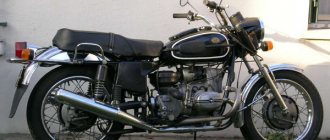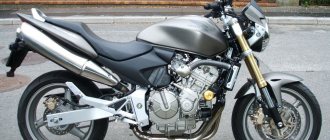Hello.
Having more or less dealt with stuntriding, we move on to freestyle motocross, that is, stunts on motocross motorcycles performed while jumping. As before, I in no way encourage you to start freestyle motocross, this article is intended for viewers who are interested in understanding what they are looking at during the next FMX show.
So, FMX originated from motocross, where, as riding techniques and the motorcycles themselves improved, the tracks began to take on an increasingly jumpy character. Some of the creases and scrubs in motocross and supercross are of a purely applied nature: they allow you to turn somewhere in a jump, or reduce the height of the jump somewhere for the sake of faster passage of the jumps. But, of course, most of the airborne motocross showmanship is for the spectators. Over time, this show off grew into a separate technical, complex and dangerous sport called freestyle motocross or FMX.
Motorcycles for FMX are modified motocross ones. They make additional hooks to make it easier to grab onto some of the plastic elements of the motorcycle when jumping, tune the suspension, and actively fight excess weight.
In the short time of its existence, freestyle motocross has gained great popularity, and now almost no self-respecting extreme festival can do without FMX demonstrations. So let's take a look at the FMX stunts performed while jumping on motorcycles. Here we have a much larger variety of elements and, unlike stunt riding, they are much more difficult to group in any way, although we will try.
What motorcycles are most commonly used?
Sports models are usually chosen for stunting. There are 3 reasons for this:
- Power
- Ease
- Short wheelbase
Sports motorcycle models are among the lightest, and this is a definite plus when a stunt requires managing the weight of the bike. The structure of the frame, ergonomics (“Motorcycle ergonomics - what is it?”), the structure of the suspension and the length of the working base (“How does the length of a motorcycle affect its handling?”) Sports motorcycles have the best maneuverability characteristics. Remember that short bikes are capable of making sharp and short corners to the limit? That's the same! They love this in stuntriding!
Regardless of the level of work done into the design of the model, you should only train or perform on warmed up motorcycles! Even if you are just a fan of driving backwards from a traffic light, on cold tires this is too rash a decision!
Judging
With the development of freestyle motocross as a separate discipline, judging rules were developed. The rating of a rider's performance consists of five criteria on a 10-point scale.
To get the highest score, freestyle motocross riders ensure that their tricks are different:
- technicality;
- complexity;
- entertainment;
- diversity;
- public reaction.
The show is evaluated by as many teams of judges as there are defined parameters to determine the winner.
What do they change on a motorcycle?
The more complex tricks the driver learns, the more changes the motorcycle undergoes, especially after falls and future repairs. The rider can modify the bike as his or her experience grows, rather than jumping into a total overhaul from day one. Many people give up when they realize how much effort and money this hobby requires.
If you're really serious about converting your bike to stunt riding, it's going to be a massive undertaking.
What needs to be changed:
- Removing everything unnecessary - plastic, mirrors, optics
- Replacing the steering wheel and yoke
- Installation of protective bars and additional steps
- Replacing stars, playing with gear ratios
- Suspension adjustment
- Forced engine ventilation
- Oil intake, motorcycle starvation problem
- Crankcase ventilation problem
- Exhaust system
- Changing the seat - leg hole
- Tank Change - Concave Cap
- Modification of the brake system
- It is possible to replace the chain with a reinforced one
- Track tires for better grip on asphalt
- Working on the clutch and idle speed
Let's look at the initial modifications, which are enough for a beginner who is learning short wheelies, stoppies and drifts. Short, because it is fraught for the engine to work in an unnatural position, and a novice stunt rider will only succeed in tricks once every ten falls. Riding in a wheelie or stoppie for no more than 10-15 seconds should not starve the engine of a beginner right away, besides, the “beginner” is not yet ready to perform tricks for a long time.
Those who wrote their name in the history of freestyle motocross
The pioneers who paved the way for freestyle motorcycling actually created a new type of motorsport. They finished their careers a long time ago. However, the names of these masters, forever inscribed in the history of the sport, are remembered and revered by thousands of fans and motocross enthusiasts. Beginners learn from the tricks of the pioneers and professionals of the current generation of freestyle motocross calculate flight trajectories.
Mike Jones' name is directly associated with supercross racing in the 90s. and with victories at the European Championships. However, over time, injuries forced Mike to switch to FMX and devote his career to stunts.
With 72 wins and 7 titles, Jeremy McGraff (Southern California) is known as the King of Supercross. Thanks to his jumps, freestyle motocross crystallized into a separate discipline.
Nate Adams has many championship titles from popular freestyle motocross competitions. It is noteworthy that Adams received his first title in 2002, at the age of 18.
Travis Pastrana, the founder of freestyle motocross, is considered the most decorated competitor in motocross, supercross, rally and FMX. Travis is the first rider to master a double backflip (2006).
Later the following were added to the American motofreestylers:
- unsurpassed record holder Australian Robbie Maddison, who was nicknamed “Daredevil” for his crazy jumps;
- Swiss Maté Ribot is the first official World Champion.
Russian freestyle motorcycle athletes regularly captivate spectators by performing original “2 in 1” tricks, without wearing heavy special equipment.
The complexity of the tricks of Alexey Kolesnikov, the only Russian participant in the world stages of Red Bull, surpassed the analogues of Americans and Europeans in terms of skill. Alexey is known for his performances in the FMX 13 team with Alex Aisin, Kirill Gavrilov and Anton Smirnov.
Nikolay Ivankov set two Russian records in FMX and is known for his successful participation in the international competitions “Night of Jumps”.
The Yarygin brothers, regular participants and winners of international competitions, also have many unique achievements and records.
Vladimir's name is famous for the first backflip among Russians. Mikhail has the title of World Champion 2012 in the “Whip Competition”.
Pyotr Andreev came to freestyle motocross after cycling shows and continued to compete at the world level.
Thanks to the outstanding performances of professionals at organized competitions and demonstrations, freestyle motocross is developing and attracting many amateurs.
Plastic and protection
The first thing any proper stunt rider does is remove excess plastic and put on maximum protection. Among motorcyclists, who falls more often than a novice stunt performer? Come on, surprise me? The plastic can be left, used as space for advertising your blog or as tuning. But after the first couple of hundred falls, you’ll wonder if plastic is needed at all? Mirrors are also in the firebox. The pro trains on special grounds. Functionally, mirrors are not needed there, and even if they fall, they break like crazy.
Different levels of protection are installed on the motorcycle, which saves on repairing the engine and other vulnerable components. At first it seems that such a set of armor protection is too wasteful a gift, but when you start calculating the cost of repairs without it, and then converting it into our wooden rubles... you silently agree with the price of protection. We discussed it in the article (“Protective bars, safety cages and sliders on a motorcycle”).
The engine protection cage must dissipate impact forces without risking damage to the frame, so it is better to choose cages with the maximum number of fasteners.
Stuntriders choose engine cages, as well as an additional subframe stiffening frame and protection for the tail of the motorcycle, which is important in tricks with the tail touching the asphalt or when falling on its side. You don't have to have everything, but a combination of several solutions is worth considering.
Subcage - an arched structure of the tail section, which has side steps, is installed as an additional frame of rigidity for the subframe.
The round bar is also an arched tail protection that encircles the tail of the motorcycle and protects it when the tail touches the asphalt. If you see sparks flying at such moments, then most likely it is not plastic, but a round bar.
A yoke is a frame, which is sometimes called a “mop”, “brush” and other associations. It is beneficial to install it not only as protection for the tail section, but also as additional support. The yoke allows you to place the motorcycle vertically; due to its U-shape, it will be stable. It is also used as a support for the rider’s legs while performing a trick.
Hint: many people completely forget about radiator protection. The bottom line is that due to frequent landings on the front wheel from the top point, the radiator mounts wear out faster. The likelihood that these fasteners at one not-so-great moment will decide to eject and throw the radiator overboard is quite real, therefore, in order not to tempt fate and not increase the cost of repairs, it is better to take care of the fasteners in advance.
It is useful for a beginner to install a circuit protector. Simply, if you fall frequently, your feet or clothing may get caught in the moving parts of the motorcycle. It seems like a small thing, but the toes often slip off.
Motofreestyle
Freestyle motocross is a sport based on acrobatic elements with a motorcycle, performed while jumping from special springboards. Unlike stunt riding, freestyle motocross only uses motocross motorcycles.
Whip
Whip or whip is a jump in which the rider attempts to position the motorcycle as horizontally as possible and then returns it to a vertical position to land.
Backflip
Backflip - a “backflip” on a motorcycle - is one of the foundations of all freestyle motocross.
Double backflip
Long considered impossible, the double backflip was demonstrated by Travis Pastrana in 2006 and later by several other riders.
Frontflip
Frontflip or “front flip” is one of the most difficult elements of modern freestyle motocross.
360 degrees
360 degrees is a trick that requires you to rotate your motorcycle 360 degrees in the air.
Body Variation
Body Varial is a trick in which the athlete turns 360 degrees over a motorcycle while the motorcycle flies along a normal trajectory.
Cliff Hanger
Cliff Hanger - requires the athlete to hook his feet to the handlebars, stretching his body and arms up.
Hart Attack
Hart Attack - standing upside down on a motorcycle, while jumping the rider holds the handlebars with one hand and leans on the seat with the other.
Replacing the steering wheel and yoke
Traditionally, stuntriders choose to replace the handlebars with clip-ons (“Clip-ons on a motorcycle, when are they needed?”) or a motocross handlebar. There is a strong opinion that it is more convenient to ride with a cross steering wheel, while performing tricks is easier with clip-ons.
There is another logical consequence in this. Clip-ons are easier to replace after many falls. By the way, after the same falls, the brilliant idea comes to remove the headlight. It’s a shame to brush the asphalt with it, and there’s no point in using it if you’re not going to show off somersaults on public roads at night.
Popular competitions
Freestyle motocross is held as an independent competition or as part of a complex of competitions with other extreme sports. All professional riders and crowds of spectators are eager to get to the popular freestyle moto world championship called “Night of the Jumps”.
The world show tour with the unofficial status of “Modern Gladiator Fights” (Red Bull) is also popular. Unforgettable are the traditional competitions that appeared with the separation of freestyle motocross into a separate discipline - “X - Games”. Among other competitions, the public appreciates “Masters of Mud”, “Masters of Adrenaline” and “Gravity Games”.
Tire tread
In stunt riding, as on the race track, the grip of the motorcycle with the road surface is very important. Yes, warm tires increase your chances of success. But the less pattern and moisture-wicking channels there are in the tread, the more comfortable it will be to perform. Extreme riders have found that the rear tire can be left on a regular street pattern and the front tire can be fitted with a slick. We read about motorcycle tires in the article “Types of motorcycle tire treads. Classifications". Of course, tires for sports motorcycles wear out at wild speeds, and after drifting they literally melt before our eyes, but beauty, sport and skill require sacrifice.
In the next article we will look at more advanced innovations that are necessary for an experienced stunt rider.
Honda CBR 600 F4i
Of all the bike models, the CBR 600 F 4 i is considered the most prepared for stunt riding.
This motorcycle has repeatedly taken first places in world-class competitions.
It is reliable, like all Hondas, it is difficult to break it.
Advantages:
- - indestructible motor
- — the problem with oil starvation can be easily solved by installing a partition in the engine crankcase
- — a strong frame and subframe from the factory that do not require additional reinforcement
This stunt bike seems to be devoid of shortcomings. But there are moments where he is inferior to his classmates:
- — due to the reliability of the engine, the power is slightly lower (the lower the power, the more reliable the motor)
- — the front fork is a regular, non-inverted one, so for rigidity you will have to work on the selection of springs and oil viscosity
- — the weight of the motorcycle is not much, but more than its competitors











